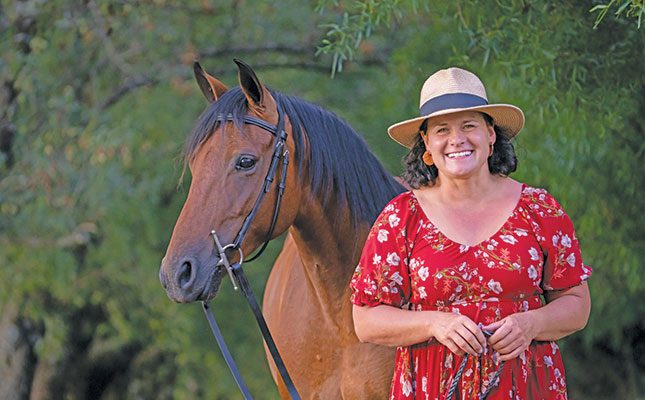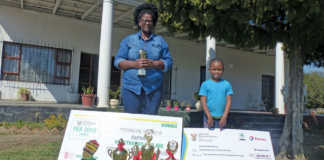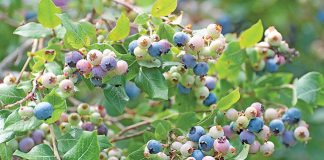
Photo: Supplied
Liezelle Whitehead, owner of the Joop Boerperd Stud and breeder of four SA Boerperd Futurity foals, is passionate about her horses.
According to her, the Boerperd could be described as the apex horse breed in the country in terms of versatility, adaptation, intelligence and hardiness. These attributes have been finely honed since its ancestors arrived in the country around 1652.
The first horses’ progeny took part in the Voortrekkers’ Great Trek as well as the Anglo-Boer War, and from these horses flowed the eight bloodlines allowed by the SA Boerperd Horse Breeders’ Society, namely the Cloete, A2, Hancke, Steenkamp, Odendaal, Middleton, Streicher and Namib bloodlines.
The society has not, from 2002, allowed new or estranged bloodlines into the breeding programme, as the huge gene pool within the society is sufficient to prevent inbreeding.
Whitehead’s dedication to selective mating, very strict adherence to selection criteria and insistence on conformation and movement of her horses resulted in her walking away four times in a row with the prestigious SA Boerperd Star Foal (Futurity Foal) awards. She is the only breeder to have earned this award four times.
The SA Boerperd Horse Breeders’ Society of South Africa said in a statement the objective of the competition was to afford breeders the opportunity to obtain breeding rights from stallions that were usually not available on the open market.
It allows new and upcoming studs access to top genetics, making it possible for them to compete on an even playing field with more established stud concerns. An added bonus is that 60% of the R1 000 entrance fees for the competition is used as prize money for the winners.
“This makes it possible for breeders to realise their dreams of breeding the ultimate Boerperd,” says Whitehead.
“For the breeder of the stallion (Star Stallion) that is made available for mating, it creates an opportunity to prove the horse is a breeding sire of choice. And the same goes for the dam (Star Mare). Their progeny eventually competes against each other in the Star Foal competition. The competition lasts for a period of some two years, from the selection of the breeding stallion and mare to the announcement of the winners.”
Roemryk Ingenieur
Whitehead’s Joop SA Boerperd stud was started 16 years ago when she acquired her first three mares from the Jacobsz family from Ermelo. This was followed by an exceptional stallion, Roemryk Ingenieur, bred by the late Lomon Terreblanche, former owner of the Roemryk stud.
The stud is named after Whitehead’s grandfather Kerneels van Rensburg, whose nickname was Joop. They shared a passion for horses, and Whitehead attributes her love for horses, and the Boerperd in particular, to him.
“From a very young age, I was infatuated with horses. At the age of 11, for instance, I took all my savings to buy myself two horses. They were just ordinary horses, but to me they were the most beautiful horses in the world. These horses, a mare and a stallion, put me on the road towards stud horse breeding,” she says.
Cloete and A2
The Joop genetics are based on a combination of the Cloete and A2 bloodlines. Whitehead prefers aristocratic-looking horses with delicate features.
Her goal is to breed horses that are, amongst others, well-rounded and characterised by an outstanding topline, a well-defined throat, agile neck and straight and well-defined legs.
An even, yet competitive, temperament is of the essence.
The initial stallion she bought, Roemryk Ingenieur, formed the foundation of the Joop lineage, and his genetic contribution still typifies the Joop horses. These horses typically present with long necks and excellent conformation of the head.
Susannasvlei
The 15-strong Joop stud, including four broodmares, is run on Whitehead’s farm Susannasvlei near Bethlehem in the Free State, with grazing consisting of red grass (Themeda triandra), weeping love grass (Eragrostis curvula) and tough love grass (Eragrostis plana).
The average temperatures fluctuate between -8°C in winter to the mid 30s in summer. The average rainfall is about 700mm per annum.
Her breeding principles are based on genetics, coupled with visual appraisal and the conformity of the animals. She also pays much attention to the original form of the breed and spends countless hours researching the form and function of the horses as far as 50 years ago.
Because of the fact that the Boerperd society kept detailed records over a long period of time, it is relatively easy to find a horse’s progeny.
“However, I find it vitally important to visually inspect the proposed breeding animal’s progeny before making any decisions. I insist on physically evaluating the stallion’s foals of the past two years as well as their dams in order to determine if the animals are suitable to the vision I have for my stud.
“Heritability, uniformity and the conservation of my stud’s unique features are of utmost importance. I want my horses to always be recognisable as Joop horses. To me, it is imperative that the horses I breed are friendly, especially child-friendly, and bring joy to their prospective owners and riders,” Whitehead explains.
The foals are born on the veld and kept with their mothers until weaning at seven months, usually in April. The foals are then kept in stalls while their mothers return to the veld.
The foals are dewormed and introduced to an initial ration of 500g consisting of 12% feed concentrate twice a day mixed with teff. While in training, foals are haltered and handled daily to teach them the basics of handling and to continue making them used to being touched by humans.
Formal training
The foals are kept in the stalls and by October, according to Whitehead, they have become used to being handled. This is essential in order to reduce stress when they are first saddled up at the age of four.
The foals are let out on natural grazing at the age of 12 months and kept there until two or three years old, when they are brought in to start with their formal training.
At four years old, the Joop horses are taken to horse trainers Glenda Koen or Michiel Burger Jr, both near Clarens in the Free State.
The horses not in training are kept on the veld, and Eragrostis pastures are planted in summer. They are kept in two groups that are rotated according to a high-density grazing programme.
Maize is also produced on Susannasvlei, and the horses are kept on the maize stover in winter. They are moved to small camps in September and October and fed on Eragrostis bales.
Foaling in September
“The stallions are put to the mares between October and December for the foals to be born the following September. The annual SA Boerperd Championships take place at the end of June.
This means my young horses would be nine months old at the time of the show, should I elect to take part. Foaling in September also means that the foals have access to green and nutritious natural grazing.
“The Boerperd has been honed through hundreds of years to become a non-selective grazer that thrives under sometimes challenging conditions. They are hardy, adaptable and exceptionally patient and intelligent,” Whitehead explains.
Adherence to breed standards as set out by the Boerperd breeders’ society is not negotiable. According to Whitehead, horses are inspected at the age of no later than two-and-a-half years to maintain standards of excellence.
Qualified inspectors check every single registered horse individually before the SA Boerperd brand is put on the off-hind.
African DNA
“Although my 18-year-old son Johan is the love of my life, my horses come a close second. They are not merely a source of income, and without them my life and my son’s life would have been the poorer for it. My horses are often my solace and comfort in challenging times.
“All horses are special, but to me the Boerperd is the most superior of all. This is a tough horse with Africa in its DNA.
“The SA Boerperd is an inimitable breed that has been selected for over 300 years under very taxing conditions,” says Whitehead.
Email Liezelle Whitehead at [email protected].










